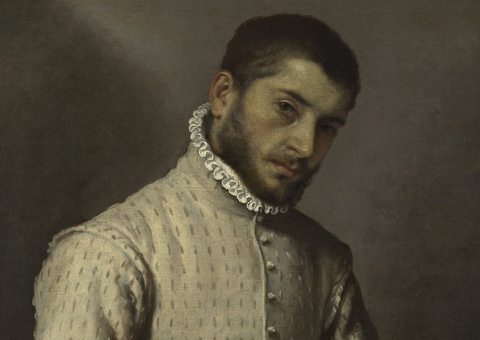Saint Sebastian – golden-haired, flawless – poses in nothing but a wisp of white loincloth. We look up at him, balletic feet in third position, arms casually folded behind his back to show off his perfect physique. There he stands in all his pale beauty, oblivious to the arrow that leaves not a drop of blood in his shapely thigh. He could be modelling for a catwalk.
Painted for Venetian monks around 1500, Cima da Conegliano’s altarpiece is hardly a martyrdom. It omits the tree to which the saint is traditionally roped, glosses over his agonising torture. Sebastian was a cult in these parts, the saint who protected ordinary mortals from the plague, and visions of his extraordinary serenity abound. But the difference between this one and all those around it, at the Royal Academy, is this insistence on the body beautiful. Sebastian is not naked so much as (nearly) nude.
We speak of the naked truth, the naked ape – as in stripped bare, helplessly or forcibly exposed. And there are plenty of naked people in this show, generally on their way to hell or tormented on earth, like Hans Baldung’s shocking woodcut of Aristotle on all fours, bridled and ridden round a garden. But the nude, from Michelangelo’s David to Botticelli’s Venus, is a Renaissance advance. Medieval art has its fig-leafed Adam and Eve, its bare sinners roasting in eternal flames, but Renaissance art pictures the nude as classical, heroic, ideal, sometimes even as real.
It seems to begin with a more personal or mystical sense of Christianity: Jesus on the ground, not high on the cross. The Flemish artist Jan Gossart brings Christ so close you see the dirt beneath his toenails, the blue veins in his knees, which project straight out of the picture. A magnificent man brought low, he crouches in anguish on a cold stone step, stripped before being scourged.
St Jerome, in Donatello’s astonishing polychrome sculpture, beats a rock against his concave chest, pitifully emaciated yet still standing. The nude Bathsheba, from Renaissance Italy to France, is as beautiful as she must be to catch King David’s eye. There are as many Eves as Adams here, from Lucas Cranach’s impossibly sinuous teenagers to Dürer’s manly Eve, weighing the apple like a shot put. Not until Pisanello’s startling sketch of a woman with an afro, halfway through, is there any sense of artists depicting women from the life.
But propriety gives way with Titian’s marvellous thigh-length Venus, wading ashore as she wrings out her tresses, supposedly a likeness of his mistress. Monumental yet sensual, she is both goddess and woman: not beyond our imagination or reach. And floating beside her, like a skit on Botticelli’s giant scallop of a vessel, is a tiny humanising shell.
Titian’s masterpiece is the high point of this show, along with spectacularly vital drawings by Dürer, Raphael and Michelangelo. But it is otherwise a most bizarre selection, cut down from a larger exhibition at the Getty Museum in Los Angeles, here shorn of many paintings and heavily reliant on northern European prints.
The range is still wide, from erotic illuminated manuscripts commissioned by French aristocrats to wood carvings, bronze medals and marble portrait busts. There are drawings where the bare body remains visible beneath scant drapes; paintings where the clothes are semi-transparent, or just being removed. Luca Signorelli’s Figures in a Landscape shows one youth sitting nude on a rock while another pulls off – or is it on? – the shirt that would cover his buttocks and thighs. Part of an altarpiece devoted to St Christopher, the traditional suggestion is that the boys are also about to wade into a river, but it hardly explains the all-out insistence on this naked back view.
How and why the nude was depicted is the show’s central question. The answers are as various as the works: a fat bronze Cupid with goitrous cheeks signifying lust over love; a raddled faun lamenting the virginal purity of a dead nymph; a dozen muscle men fighting for no apparent reason except to show off the artist’s gift for anatomy. In Hans Memling’s painted panels, nudity is all about sloth and vanity – yet it seems just as likely that the pretext for painting a lovely young nude staring at herself in the mirror was to inflame the desires of the viewer.
Which is one of the contradictions of The Renaissance Nude, together with its wildly discrepant ideas of beauty, skinny to stout, delicate to snub-nosed, wan to macho to androgynous. No matter how puritanical the message, how political or religious, the undressed figure may equally come across as erotic or profane. Christ is humanised by his nakedness, but as godlike as any Apollo, and vice versa, in Renaissance art. It is as if the nude could shrug off its context.
The Renaissance Nude is at the Royal Academy, London, until 2 June











